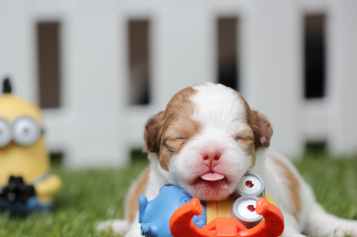In continuation of my getting ready for puppy series, here is Potty Training pt 2.
4 Rule of thumb 1 hour per month of age, give or take an hour
5 Feeding schedules are very useful
6 A crate is your friend
5 Feeding schedules are very useful
6 A crate is your friend

The Rule of Thumb – There is a general rule that trainers follow that goes along with lines of this… A puppy is able to hold their bladder for an hour per month of age, give or take an hour. So if your puppy is 3 months old, they can hold their bladder at most for 2-4 hours. This is not a steadfast rule it’s a generalization. Some pups can hold their bladder long, and some just can’t. They are born similar to our human children, their bodies and organs are still growing inside of them. If spank them or get onto them for having a potty accident in the house, they just learn to hide it better.
Feeding Schedules are your friends – When I talk to pet parents about feeding schedules I mean that loosely. I don’t mean that you have to feed your puppy at 6am and 6pm on the dot.
- Give your puppy their meal, a lot 15-20 minutes for them to eat and then put them in their crate for 30-45 minutes (you can put their food in their crate with them, but you have to keep an eye on when they finish eating)
- Leash up your puppy and take them outside.
- Go to one spot and stand there, do not interact with them.
- They need to get bored to go potty.
- If they have not pottied within 10 minutes, take them back inside and put them back in their crate for another 10-15.
- Leash them up and try again, repeat until they go potty.
Part of the problem is we think our dogs need to walk around and sniff and find the right spot, however, is just a huge distraction. Our puppies get to running around and playing and forget why they are outside, then when we come inside everything is boring to them. They remember then that they need to go potty, and then we go right there just back inside the house.
For Peeing in the house, Puppies need to go outside:
For Peeing in the house, Puppies need to go outside:
- Within 5-10 minutes of visiting the water bowl
- After waking up, even if it’s only been a short nap
- After playtime
- Every 30 to 45 minutes, until they are able to hold their bladders.
I’m in the middle of potty training a 3 yr old as well and I have to say, the similarities between potty training a puppy and a human child are definitely there!!
 A crate is your friend – One of the things I hear a lot is that people think that putting their puppy in a crate is mean or is punishment. Honestly, you have to look at it like this, when your toddler was learning how to explore the world around them, what did you do? You put them in a playpen or a bouncy chair. So that we knew they were safe.
A crate is your friend – One of the things I hear a lot is that people think that putting their puppy in a crate is mean or is punishment. Honestly, you have to look at it like this, when your toddler was learning how to explore the world around them, what did you do? You put them in a playpen or a bouncy chair. So that we knew they were safe.The same thing applies to our puppies. They do not know what is safe and what is dangerous, all they know is how to toddle around and put everything into their mouths. When our eyes can’t be on them, their crate is the best place for them.
Stay tuned for more…
You have done a great job on this article. It’s very readable and highly intelligent. You have even managed to make it understandable and easy to read. You have some real writing talent. Thank you. aggressive dog training
ReplyDelete